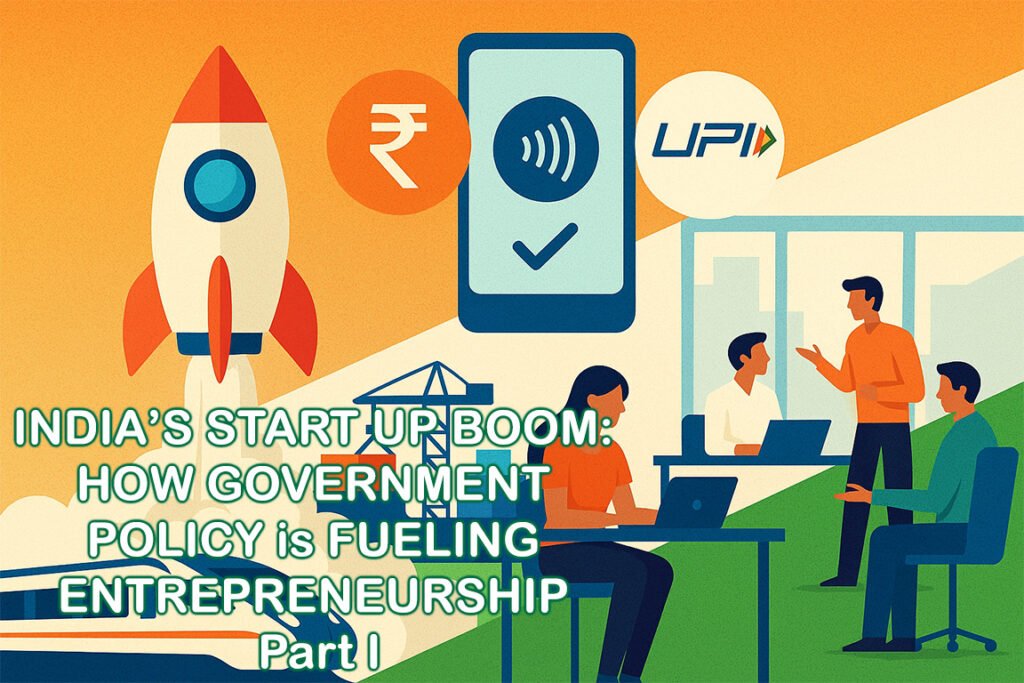
India’s Startup Boom: How Government Policy is Fueling Entrepreneurship Part I
A decade ago, India’s startup landscape was largely confined to a handful of tech hubs like Bengaluru, Gurgaon, and Hyderabad. Entrepreneurship was seen as risky, and many graduates preferred secure corporate jobs or government services. Access to funding, mentorship, and regulatory support was limited, and aspiring entrepreneurs struggled to navigate India’s bureaucracy. There was only one unicorn or a billion dollar startup in India in 2014.
Fast forward to 2025, and the picture has dramatically changed. India is now the third-largest startup ecosystem in the world, with more than 117,000 recognised startups across 700 districts and over 110 unicorns valued at $350 billion. But with targeted policies, India has witnessed a cultural shift—today, nearly half of all startups are based in Tier II and III cities, proving that entrepreneurial energy is spreading across the country. This transformation has been enabled by policy support, digital infrastructure, and cultural change, all of which have lowered entry barriers and made entrepreneurship more inclusive. The Startup India program has created 1.7 million direct jobs since 2016, with 40% in tech-related sectors as of May 2025.
Government Initiatives That Changed the Game
Startup India (2016)
Launched in January 2016, Startup India placed entrepreneurship at the heart of national policy. It offers three years of tax exemption, easier compliance norms, and fast-track patent processing. Over 117,000 startups have been recognised under this scheme, spanning 56 sectors, including agritech, fintech, climate tech, and space. Nearly 49% of them are based outside metro cities. The Startup India has created 1.7 million direct jobs since 2016, with 40% in tech-related sectors as of May 2025. 1.47 lakh jobs were created in Healthcare & Lifesciences.
Fund of Funds for Startups (FFS)
To address the lack of venture capital, the government created a ₹10,000 crore fund managed by SIDBI. Instead of directly funding startups, it invests in SEBI-registered venture funds, which then support startups. This indirect model has supported more than 700 startups by enabling over 120 venture funds to invest in high-growth companies. This helped crowd-in private capital by reducing investor risk. It also enabled sectors like deeptech, SaaS, and healthcare to attract institutional investment.
Startup India Seed Fund Scheme (SISFS)
Seed capital is the hardest to secure. To address this, the SISFS launched in 2021 with ₹945 crore. It provides grants of up to ₹20 lakh for proof-of-concept and ₹50 lakh for scaling. Already, more than 1,500 startups have benefited, particularly in Tier II and III cities through 150+ incubators. The Scheme had a strong focus on Tier II/III entrepreneurs, ensuring that smaller cities are not left behind.
Atal Innovation Mission (AIM)
Innovation must start early. AIM set up Atal Tinkering Labs in schools to provide access to robotics, IoT, and 3D printing. Over 10,000 labs have been established, reaching more than 7.5 million students across India. This program nurtures creative problem-solving among children and creates the foundation for future entrepreneurs.
Stand-Up India
Inclusion has been central to India’s startup story. Stand-Up India provides loans between ₹10 lakh and ₹1 crore to at least one woman entrepreneur and one SC/ST entrepreneur per bank branch. Since 2016, more than 1.6 lakh women and 1.3 lakh SC/ST entrepreneurs have benefited, widening access to capital.
Digital India & India Stack
India’s digital infrastructure Aadhaar, UPI, DigiLocker has transformed the startup landscape. In 2023 alone, India recorded 120 billion UPI transactions, enabling fintech startups to scale rapidly. Digital public goods have lowered entry barriers for millions of small businesses and consumers. UPI is the world’s largest digital payment system in 2025, with 18 billion transactions a month.
Production Linked Incentive (PLI) Schemes
To make India a manufacturing hub, the government launched PLI schemes in 14 sectors, including electronics, EVs, drones, and pharma. This has spurred startups in advanced manufacturing. Electronics turnover crossed ₹10 lakh crore in 2023, and startups like Ola Electric and ideaForge have gained international recognition. There are startups even entering critical sectors like chip manufacturing with the help of PLI scheme.
Incubators and Centres of Excellence
India now has more than 650 incubators and accelerators, many linked to IITs, IIMs, and NITs. These hubs provide mentorship, testing facilities, and networking opportunities. Initiatives like NASSCOM’s 10,000 Startups program have mentored thousands of early-stage founders, particularly in AI and deeptech.
Employment and Economic Impact
Since 2016, startups have created more than 1.7 million direct jobs. IT services, healthcare, fintech, and edtech dominate this employment landscape, while millions more are indirectly supported through gig work, logistics, and supply chains. The startup ecosystem has thus become a significant pillar of India’s economy.
Conclusion
India’s startup boom is not an accident; it is the result of deliberate policies, digital infrastructure, and changing social norms. Government schemes like Startup India, Seed Fund, Stand-Up India, and Digital India have created an enabling environment for entrepreneurs to thrive.
But the journey is far from over. To truly harness its demographic dividend, India must embed entrepreneurship into its social fabric where taking risks is applauded, failures are seen as learning, and innovation becomes part of everyday life.